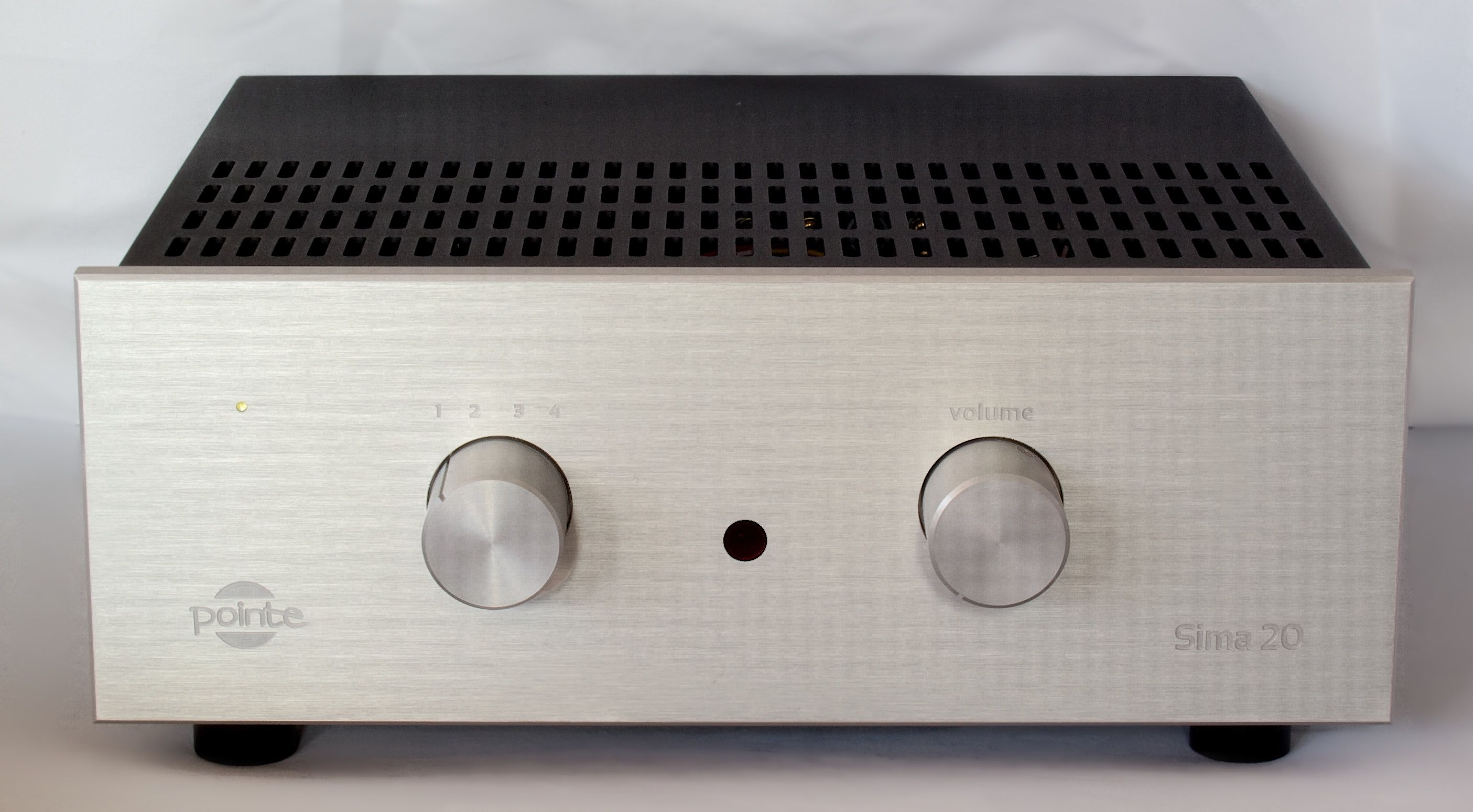Pointe Sima 20 (2013)

Exactly 20 years have passed since the first Pointe amplifier, the Sima was introduced to the markets. The original Sima and its siblings, the Sima Mk2 and the Sima Jubilee have been the most successful Pointe models ever. For the 20th anniversary we have re-considered the original concept: 20 years ago we just wanted to offer an amplifier that gives decent sound for little money. Now we aimed higher and wanted to design an amplifier that sounds and looks like the classiest competition on the global markets today.
The design of the Sima 20’s faceplate is similar to the original design: a rectangle with two circles, and that’s it. The housing is somewhat bigger than the predecessor’s, and, more importantly, it is much more sophisticated: the fascia is a sturdy, finely brushed aluminum plate, with 3D engravings, and custom-machined solid aluminum knobs. To enhance the elegance of the Sima 20, a warm white led is indicating that the unit is powered on.
The housing is completely made of aluminum. Aluminum is a low-resonance and anti-magnetic material, which has a positive effect on the sound. The housing is a robust construction, a Pointe earmark, with multiple braces along the chassis, and a well thought-out ventilation pattern that makes sure the thermic conditions inside the house are stable and under control.
A solid aluminum block remote control is included. Apart from the remote controlled volume, the Sima 20’s features are minimalistic: it has an on/off switch (on the back of the unit), a volume knob and four line inputs.
The new Sima 20 might resemble its 20-year-old predecessor by its looks and dimensions, but on the inside it is completely different. The only feature they share is that they both run on EL84 power tubes.
The birth of the Sima 20 was stimulated by the fact that we managed to get hold of probably the last stock of a truly exceptional EL 84 NOS tube. (NOS stands for New Old Stock, and refers to merchandise being offered for sale which was manufactured long ago but that has never been used.) The tubes carry an Ei logo and the Made in Yugoslavia text, but these tubes were actually produced by Tungsram in Hungary. Even today these tubes are considered a reference for their technical quality – and, at least as importantly, their highly musical sound.
In the pre-amp section of the Sima 20 there are some more NOS tubes (2 x ECF80), these are “real” Ei Yugoslav products. The ECF80 type was selected for shortening the signal path: the pentode in this combined tube manages line-level amplification, while the triode is responsible for the phase inversion, so only one pair of anode resistors and one pair of coupling capacitors were needed in the signal path.
The tube sockets are ceramic ones. Bias for the tubes is optimized automatically, there is no need for manual adjustments even in the case of tube replacement.
In the power supply section of the amplifier there is an E-I iron-core transformer, instead of a more widely applied toroidal-type transformer, which was made possible by the EL 84 power tubes. E-I core transformers often sound better than the toroidals.
The power supply is remarkable not only for the transformer, though: the first filtering element after the 5AR4 rectifier tube is a custom-made, double-C core choking transformer which is followed by a filtering capacitor. This circuitry provides a nearly ideal solution for a power supply – it is virtually noiseless with no current peaks, unlike the widely used input capacitor filtering.
The fully symmetrical, handmade output transformers are the products of Pointe’s post-Sixty period: they feature a double-C core construction with numerous fine innovations, a unique winding technology and a specific choice of materials. The output transformers prefer to have a load of 6-8 ohms attached to them, but they also work fine with speakers of 4 ohms impedance. They are designed to cope well with the complex load presented by complicated crossovers or hard-to-drive speaker units.
The signal circuitry was developed with an ear on music performance. Feedback is quite low at a mere 2.5 dB, which grants a dynamic, powerful, still easy and “airy” sound. The circuitry is designed to have short signal paths with its well thought-out topology, and clear and orderly internal wiring. All passive components were selected after a year-long session of listening tests, where not only the individual sound quality of each passive component was considered, but also the musical synergy between them.
Coupling capacitors are NOS oil-paper capacitors, other filtering and by-pass electrolytic capacitors are by Siemens, Panasonic and ELNA Silmic (“silk fiber”) . The anode resistors are metal film resistors by Caddock.
The Sima 20 is 100% hand-assembled, with high-quality LC-OFC internal wiring, applying high silver content soldering material. The connectors are also sophisticated, with speaker terminals of the WBT-design.
Specifications:
Nominal Power Output: 2 x 12 W. Frequency Range: 10 Hz – 60 kz (+0/-3 dB, 1W). Input impedance: 50 kOhm. Sign-to-Noise Ratio: 85 dB. Tube set: 4 x EL84, 2 x ECF80, 1 x 5AR4. Dimensions: 365 x 310 x 155 mm. Weight: 12 kg.
Price: EUR 1,490 + VAT
Reviews:
“The Victory of the Minimal,” Audiolife, January 2014
“No Easy Going,” Hifi Piac, February 2014
“Sitting at the Fireplace,” Hangzásvilág, May 2014










